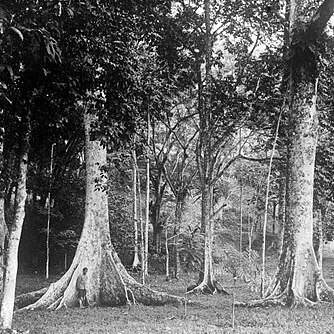Tree, 30-60 by 1.5-2 m, with very large buttresses (up to 8 m high and 5 m wide). Branchlets 1-1.5 cm diam., angular, glabrescent, with large leaf-scars, terminal bud slender, acute, 4-5 cm by 6 mm, densely brown-tomentose; pith thick with many peripherally arranged small vascular strands. Stipules represented by the basal pair of leaflets, which are rather caducous — leaving a small circular scar —, inserted at the conjunction of branch and petiole and very small (petiolule 4-10 mm, blade 1.5-2.5 by ¾-2 cm). Leaves spirally arranged, (3-)4-5(-6)-jugate, 35-45 cm long. Leaflets ovate to oblong, 5-10-30 by 2½-5-10 cm, stiff-chartaceous to coriaceous, glabrescent; base rounded to subcordate; margin entire; apex gradually long and acutely acuminate; nerves 17-22-26 pairs (angle c. 60°), tortuous, towards the margin dissolving into a lax marginal reticulation, rather prominent beneath, some of the nerves more or less reduced (similar to intermediate veins); reticulations dense; leaflets of the upper pairs sometimes on the basiscopic side decurrent till the rachis. Inflorescences axillary, narrowly paniculate, densely minutely tomentose, male 4-19 cm long, many-flowered, main branches up to 6.5 cm, flowers clustered; female 5-7 cm, few-flowered, main branches very short. Bracts lanceolate to subulate. Flowers pubescent, ♂ 7-9 mm, female 8-14 mm. Calyx ♂ 3.5 mm high, female 4.5-7 mm. Stamens free, glabrous. Disk ♂ cushion-shaped, 2 mm high, faintly 6-lobed, densely pilose;, female 6-lobed, 1 mm high, fimbriate. Pistil pubescent, ♂ none. Infructescences subracemose, with few fruits; calyx flat, 1 cm diam. Fruits ellipsoid, sub-trigonous in cross-section, 7-8½ by 4½-6 cm, up to 12 cm long, glabrescent, scabrous; pyrene smooth except of 3 angle-ribs near the apex and a faint median rib on each of the lids; lids 4-5 mm thick. Seeds (3-)2-l; cells irregularly shaped, sterile ones not or slightly reduced.
More
A large tree with very large buttresses. These can be 8 m high and 5 m across. The tree grows to 30-60 m high. The trunk can be 1-2 m across. The small branches are 1-1.5 cm across and angular. These leave large leaf scars. At the base of the leaf stalk there are small stipules that look like small simple leaves without teeth around the edge. The leaves are arranged in spirals. They are made up of 4-6 pairs of leaflets. The leaves are 35-45 cm long and the leaflets are oval and between 5-30 cm long by 3-10 cm wide. The leaflets are stiff and papery. The base of the leaflets is rounded. The tip of the leaf tapers to a point. The flower clusters occur in the axils of leaves. The male flower clusters are 4-19 cm long with many flowers, while the female flower clusters are 5-7 cm long and with few flowers. The fruiting cluster has few fruits and there is not one flower at the end of the cluster. The fruit are somewhat triangular in cross section and 7-8 cm long by 4-6 cm wide. There can be 1 to 3 seeds inside the fruit.


